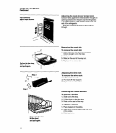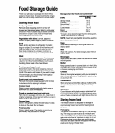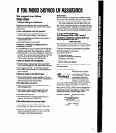
Food Storage Guide
There is a right way to package and store refrig-
erated or frozen food. To keep food fresher, longer,
take the time to study these recommended steps.
Storing fresh food
Leafy vegetables
Remove store wrapping and trim or tear off
bruised and discolored areas. Wash in cold water
and drain. Place in plastic bag or plastic container
and store in crisper. Cold, moist air helps keep
leafy vegetables fresh and crisp.
Vegetables with skins (carrots, peppers)
Store in crisper, plastic bags or plastic container.
Fruit
Wash, let dry and store in refrigerator in plastic
bags or crisper. Do not wash or hull berries until
they are ready to use. Sort and keep berries in
their store container in a crisper, or store in a
loosely closed paper bag on a refrigerator shelf.
Meat
Meat is perishable and expensive. The following
list and chart give you packaging hints and time
limits so you won’t waste meat through careless
handling. Store meat in the meat drawer.
Fresh, prepackaged meat
Store fresh meat in the store wrapping. Vacuum
packaged meat can be frozen for as long as one
month if the seal is not broken. If you want to keep
it frozen longer, you should wrap it with special
freezer wrapping material.
Fresh meat, not prepackaged
Remove the market wrapping paper and re-wrap
in aluminum foil for storing it unfrozen.
Cooked meat
Wrap or cover cooked meat with plastic wrap or
aluminum foil. Store immediately.
Cured or smoked meat and cold cuts
Ham, bacon, sausage, cold cuts, etc., keep best in
original wrappings. Once opened, tightly re-wrap in
plastic wrap or aluminum foil.
Canned ham
Store in refrigerator unless the label says it’s okay
to store on the shelf. Do not freeze.
Fresh poultry
Wrap in plastic wrap. The plastic on poultry, as
purchased, may be used for storage.
Storage chart for fresh and cured meat’
APPROXIMATE TIME
TYPE
(DAYS)
Variety meats
1 to2
Chicken
1 to2
Ground beef
1 to2
Steaks and roasts
3 to 5
Cured meats
7to10
Bacon
5 to 7
Cold cuts. 3 to 5
‘If meat is to be stored longer than the times given,
follow the directions for freezing.
NOTE: Fresh fish and shellfish should be used the
_ same day as purchased.
Eggs
Store without washing in the original carton on
interior shelf.
Milk
Wipe milk cartons. For best storage, place milk on
interior shelf.
Beverages
Wipe bottles and cans. Store in a door bin or inside
the refrigerator.
Butter
Keep opened butter in covered dish or in the Utility
Compartment. When storing an extra supply, wrap
in freezer packaging and freeze.
Cheese
Store in the original wrapping until you are ready to
use it. Once opened, re-wrap tightly in plastic wrap
or aluminum foil.
Condiments
Store small jars and bottles (catsup, mustard, jelly,
olives) in the door bins where they are in easy
reach.
Leftovers
Cover leftovers with plastic wrap or aluminum foil
to keep food from drying out and transferring food
odors. Plastic containers with tight lids are fine, too.
Storing frozen food
The freezer section is designed for storage of
commercially frozen food and for freezing food
at home.
Packaging
The secret of successful freezing is in the packag-
ing. The wrap you use must be air, moisture and
vapor proof. The way you close and seal the pack-
age must not allow air, moisture or vapor in or out.
Packaging done in any other way could cause
food odor and taste transfer throughout the refrig-
erator and drying of frozen food.
16


















